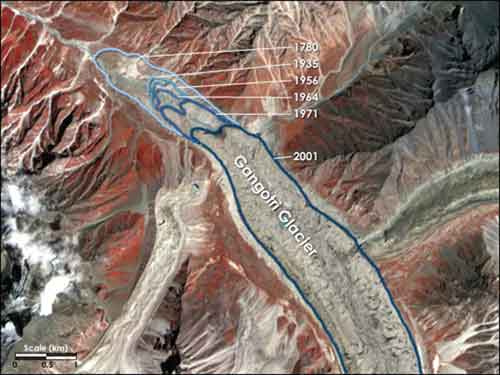
Around 1.3 billion people in the Himalayan river basins rely on both
snowmelt water from glaciers and monsoon waters to sustain their
livelihoods. In fact, seasonal snowmelt water from the Himalayan
glaciers is one of the main sources of freshwater reserves that directly
sustain people living in the region, especially in arid and semi-arid
areas, says an article in the September edition of the bulletin from the
UN Environment Programme (UNEP) Global Environmental Alert Service
(GEAS). However, the article alerts that the contribution of glacial
snow melt to the Himalayan river basins remains uncertain, due to a lack
of reliable and consistent data.
It is widely thought that climate change is influencing the rate of
glacier melt and that it poses a serious global threat. However, the
acceleration of melting of the Himalayan glaciers due to global warming
was a controversial subject in 2009-2010, which was followed by an IPCCC
statement.
Maybe this is one reason scientists have not been forward with
publication of studies on the melting of Himalayan glaciers since. We
can’t ignore, nevertheless, that temperatures at some locations in the
Himalayan region have risen faster than the global average; from1982 to
2006, the average annual mean temperature in the region increased by 1.5
°C with an average increase of 0.06 °C per year (Shrestha et al., 2012).
The bulletin article calls for better monitoring of glaciers and a
state-of-the-art science assessment of glacier change, in order to
better understand the complexities of those changes and reduce scientific uncertainty. It also highlights the need for more
scientific cooperation across countries boundaries, so that regional climate change
impacts on Himalayan glaciers can be assessed more accurately and knowledge gaps can be filled. In this way the policy makers will be provided with accurate
scientific findings to act upon.
The article also provides a
large number of references (48) to published research on the subject
and some stunning photographs and Landsat images.
I was also able to retrieve 1096 records on the subject of glaciers and climate change, from the CAB Abstracts database . Link provided for the benefit of subscribers of the CAB Abstracts database.
Image description: Gangotri Glacier, source of the
Ganges, one of the largest glaciers in the Himalayas. It has been
receding since 1780 and in recent years the pace of retreat has
accelerated.
Image credit: NASA Earth Observatory, Jesse Allen.
References
Shrestha, U.B., Gautam, S and Bawa,
K.S. (2012). Widespread climate change in the Himalayas and associated changes
in local ecosystems. PLoS One 7(5): e36741. Doi:10.1371/journal.pone.0036741.
Accessed at http://www.plosone.org/article/info:doi/10.1371/journal.pone.0036741.
UNEP-GEAS Bulletin article ‘Measuring Glacier Change in the Himalayas.’
2 Comments
Leave a Reply

I am impressed, I need to say. Actually not often do I encounter a weblog that is both educative and entertaining, and let me let you know, you’ve hit the nail on the head.Thanks a million and please carry on the good work.
I am much intrigued with the new glacier geomorphology esp. Himalayas. Can you please link with more related information and data.